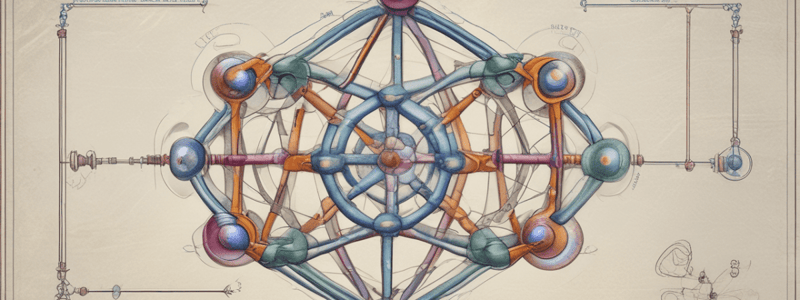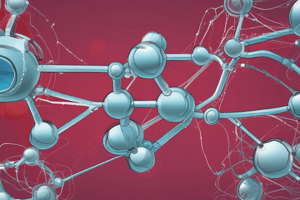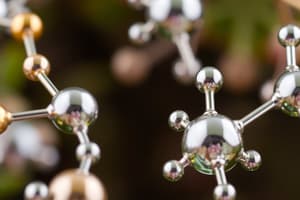Podcast
Questions and Answers
What is the primary source of ligands in bioinorganic chemistry?
What is the primary source of ligands in bioinorganic chemistry?
- Chromatin
- Amino-acid side chains and constituents of nucleic acids (correct)
- Constituents of nucleic acids
- Proteins in the matrix of a cell membrane
What does the coordination environment of residues in bioinorganic chemistry depend on?
What does the coordination environment of residues in bioinorganic chemistry depend on?
- The wrapping of DNA around the nucleosome core proteins in chromatin
- The three-dimensional folding of proteins and the tertiary structures of nucleic acids (correct)
- The positioning of proteins in the matrix of a cell membrane
- The pH of the environment
What is the purpose of this chapter?
What is the purpose of this chapter?
- To provide the basic information about bioinorganic chemistry necessary to understand later chapters (correct)
- To provide an in-depth analysis of metal-binding capabilities
- To discuss the principles of enzyme kinetics
- To explore gene cloning and expression
How many essential amino acids are there in proteins?
How many essential amino acids are there in proteins?
What is the chirality at the α-carbon of naturally occurring amino acids?
What is the chirality at the α-carbon of naturally occurring amino acids?
What can metal coordination at amino-acid side chains do?
What can metal coordination at amino-acid side chains do?
What type of bonds join amino acids in a protein?
What type of bonds join amino acids in a protein?
What is the function of the one-letter code for amino acids?
What is the function of the one-letter code for amino acids?
Which of the following amino acids is NOT a commonly observed ligand?
Which of the following amino acids is NOT a commonly observed ligand?
What is the primary structure of a protein determined by?
What is the primary structure of a protein determined by?
What type of bonds are typically found in the interior of a protein?
What type of bonds are typically found in the interior of a protein?
What is the function of the side chain of cysteine in metal ion binding?
What is the function of the side chain of cysteine in metal ion binding?
What determines the three-dimensional structure of a protein?
What determines the three-dimensional structure of a protein?
What type of interactions are important for protein structure?
What type of interactions are important for protein structure?
What is the function of the three-letter code for amino acids?
What is the function of the three-letter code for amino acids?
What determines the orientation of ligand donor atoms in a metalloprotein?
What determines the orientation of ligand donor atoms in a metalloprotein?
What refers to the local conformation of a few adjacent amino acids determined by specific hydrogen bonding patterns?
What refers to the local conformation of a few adjacent amino acids determined by specific hydrogen bonding patterns?
What is the term used to describe the overall course of a biopolymer chain that generates 'folds'?
What is the term used to describe the overall course of a biopolymer chain that generates 'folds'?
What refers to the assembly of different polypeptide chains to form larger units?
What refers to the assembly of different polypeptide chains to form larger units?
What is the name of the protein that exists as a random coil with no unique secondary or tertiary structure in the absence of Zn2+?
What is the name of the protein that exists as a random coil with no unique secondary or tertiary structure in the absence of Zn2+?
What is the term used to describe the overall course of a biopolymer chain that generates 'folds'?
What is the term used to describe the overall course of a biopolymer chain that generates 'folds'?
What type of structure is essential for the function of Cu-Zn superoxide dismutase?
What type of structure is essential for the function of Cu-Zn superoxide dismutase?
What is the name of the enzyme that is required for assembly of the intact enzyme aspartate transcarbamoylase?
What is the name of the enzyme that is required for assembly of the intact enzyme aspartate transcarbamoylase?
What ultimately determines the structure and properties of proteins?
What ultimately determines the structure and properties of proteins?
What is the first step in the pathway by which genetic information works?
What is the first step in the pathway by which genetic information works?
What is the term used to describe the manipulation of proteins through the alteration of their amino acid sequences?
What is the term used to describe the manipulation of proteins through the alteration of their amino acid sequences?
Which cellular component functions as the protein synthetic machinery?
Which cellular component functions as the protein synthetic machinery?
What is the process of removing intervening sequences within the RNA and connecting the coding regions called?
What is the process of removing intervening sequences within the RNA and connecting the coding regions called?
What is the purpose of cloning a specific gene?
What is the purpose of cloning a specific gene?
What is the term for the regions of DNA that encode the final protein?
What is the term for the regions of DNA that encode the final protein?
What is the process of identifying the member or members of the library that include the gene of interest called?
What is the process of identifying the member or members of the library that include the gene of interest called?
What is the term for the initial RNA transcript that is processed into a mature messenger RNA?
What is the term for the initial RNA transcript that is processed into a mature messenger RNA?
What is the purpose of site-directed mutagenesis?
What is the purpose of site-directed mutagenesis?
What type of cells lack a nucleus?
What type of cells lack a nucleus?
What is the term for the process of incorporating fragments of DNA into a vector?
What is the term for the process of incorporating fragments of DNA into a vector?
What is the purpose of a library in gene cloning?
What is the purpose of a library in gene cloning?
What is the name of the bond that links the sugar and the base in a nucleoside?
What is the name of the bond that links the sugar and the base in a nucleoside?
What is the term for the unit comprising only a sugar and a base?
What is the term for the unit comprising only a sugar and a base?
What is the type of RNA that carries genetic information from DNA to the ribosomes?
What is the type of RNA that carries genetic information from DNA to the ribosomes?
What is the term for the process of determining RNA secondary structure by comparing homologous RNA sequences from different organisms?
What is the term for the process of determining RNA secondary structure by comparing homologous RNA sequences from different organisms?
What is the name of the base pairing scheme that is responsible for linking the two DNA strands into a double helix?
What is the name of the base pairing scheme that is responsible for linking the two DNA strands into a double helix?
What is the term for the RNA molecule that binds amino acids to its 3’ termini and carries them to the ribosome?
What is the term for the RNA molecule that binds amino acids to its 3’ termini and carries them to the ribosome?
What is the type of RNA that is a constituent of ribosomes?
What is the type of RNA that is a constituent of ribosomes?
What is the term for the bond that links the sugar and the phosphate group in a nucleotide?
What is the term for the bond that links the sugar and the phosphate group in a nucleotide?
What is the type of RNA that is best known for its structure?
What is the type of RNA that is best known for its structure?
What is the term for the conformation of the sugar ring in RNA, where the C3’ carbon atom is on the same side of the plane defined by C4’-O-C1’ as the C5’ carbon?
What is the term for the conformation of the sugar ring in RNA, where the C3’ carbon atom is on the same side of the plane defined by C4’-O-C1’ as the C5’ carbon?
What is the purpose of the gene for antibiotic resistance in a plasmid?
What is the purpose of the gene for antibiotic resistance in a plasmid?
What is the result of the chemical transformation in the enzyme-substrate complex?
What is the result of the chemical transformation in the enzyme-substrate complex?
What is the significance of the Vmax parameter in enzyme kinetics?
What is the significance of the Vmax parameter in enzyme kinetics?
What is the difference between the sugar-phosphate backbone of DNA and RNA?
What is the difference between the sugar-phosphate backbone of DNA and RNA?
What is the purpose of introducing specific changes into the nucleotide sequence of a gene?
What is the purpose of introducing specific changes into the nucleotide sequence of a gene?
What is the role of the origin of replication in a plasmid?
What is the role of the origin of replication in a plasmid?
What is the phenomenon of substrate-saturation of the rate of the reaction?
What is the phenomenon of substrate-saturation of the rate of the reaction?
What is the result of the process of protein overexpression via a plasmid?
What is the result of the process of protein overexpression via a plasmid?
What is the name given to RNA enzymes that require metal ions for their activity?
What is the name given to RNA enzymes that require metal ions for their activity?
What is the shape of the most common form of DNA?
What is the shape of the most common form of DNA?
What is the significance of the KM parameter in enzyme kinetics?
What is the significance of the KM parameter in enzyme kinetics?
What is the purpose of the cloned DNA fragment in a plasmid?
What is the purpose of the cloned DNA fragment in a plasmid?
What is the approximate number of base pairs per turn of the helix in B-DNA?
What is the approximate number of base pairs per turn of the helix in B-DNA?
What is the sugar pucker conformation observed in A-DNA?
What is the sugar pucker conformation observed in A-DNA?
What is the reason for the poor metal-coordinating abilities of exocyclic amino groups in nucleoside bases?
What is the reason for the poor metal-coordinating abilities of exocyclic amino groups in nucleoside bases?
What is the characteristic feature of Z-DNA?
What is the characteristic feature of Z-DNA?
What is the type of RNA structure that is functionally very important?
What is the type of RNA structure that is functionally very important?
What is the name given to the metal-binding sites on nucleoside bases?
What is the name given to the metal-binding sites on nucleoside bases?
What is the reason for the sequence-dependent local variations in DNA structure?
What is the reason for the sequence-dependent local variations in DNA structure?
What is the characteristic feature of A-DNA?
What is the characteristic feature of A-DNA?
What is the purpose of introducing a sulfur atom in nucleic acids?
What is the purpose of introducing a sulfur atom in nucleic acids?
What is the significance of s4U in bioinorganic chemistry?
What is the significance of s4U in bioinorganic chemistry?
What is the role of site-specific mutagenesis in metal-nucleic acid chemistry?
What is the role of site-specific mutagenesis in metal-nucleic acid chemistry?
What is the significance of the structure of s4U in bioinorganic chemistry?
What is the significance of the structure of s4U in bioinorganic chemistry?
What is the common feature of modified nucleosides like s4U?
What is the common feature of modified nucleosides like s4U?
What is the significance of metal-nucleic acid interactions in bioinorganic chemistry?
What is the significance of metal-nucleic acid interactions in bioinorganic chemistry?
Among the nucleic acid base heteroatoms, which atoms are the most likely to be metal-binding sites?
Among the nucleic acid base heteroatoms, which atoms are the most likely to be metal-binding sites?
What type of metal ions are likely to bind to the negatively charged oxygen atoms of the phosphodiester groups?
What type of metal ions are likely to bind to the negatively charged oxygen atoms of the phosphodiester groups?
What is the estimated percentage of ATP in cells that is bound to Mg(II) ion?
What is the estimated percentage of ATP in cells that is bound to Mg(II) ion?
What is the role of Mg(II) ion in the hydrolysis of the high-energy phosphate bond in ATP?
What is the role of Mg(II) ion in the hydrolysis of the high-energy phosphate bond in ATP?
What is the function of Mg(II) ion in the binding of ATP to enzymes?
What is the function of Mg(II) ion in the binding of ATP to enzymes?
What is the role of metal ions in the stabilization of the tertiary structure of tRNA?
What is the role of metal ions in the stabilization of the tertiary structure of tRNA?
What is the function of the nucleosomes in the structure of chromatin?
What is the function of the nucleosomes in the structure of chromatin?
What is the purpose of synthesizing oligonucleotides with unique metal-binding properties?
What is the purpose of synthesizing oligonucleotides with unique metal-binding properties?
What is the result of binding Pb(II) to tRNA?
What is the result of binding Pb(II) to tRNA?
What is the role of Mg(II) ion in the structure of chromatin?
What is the role of Mg(II) ion in the structure of chromatin?
Flashcards are hidden until you start studying




